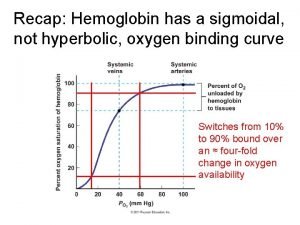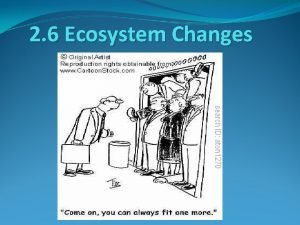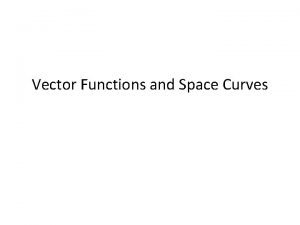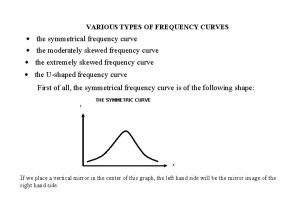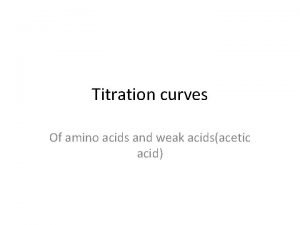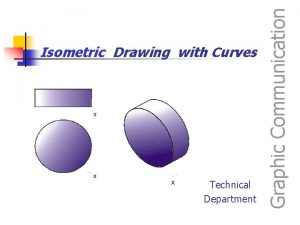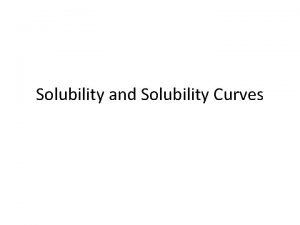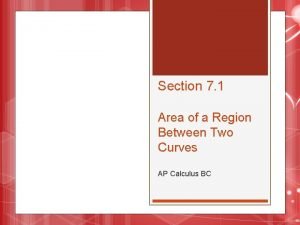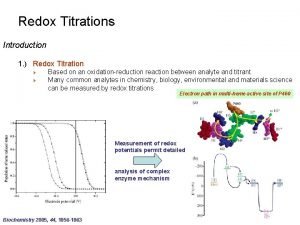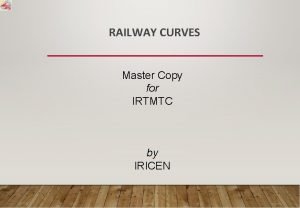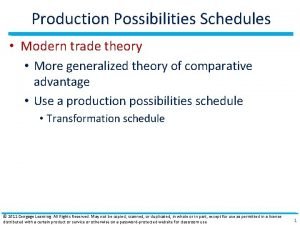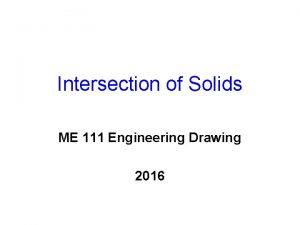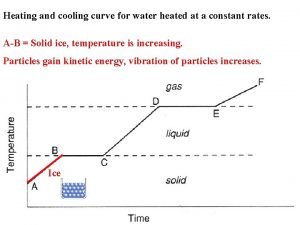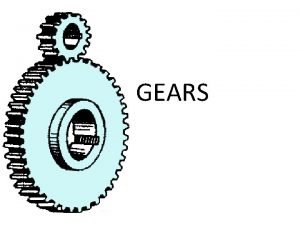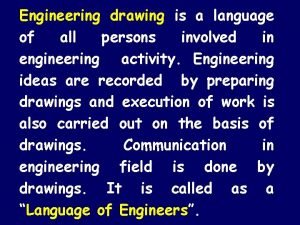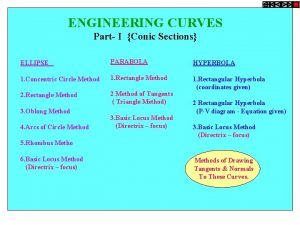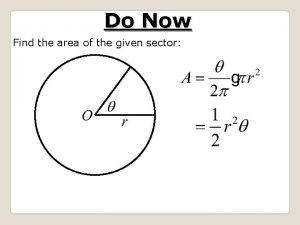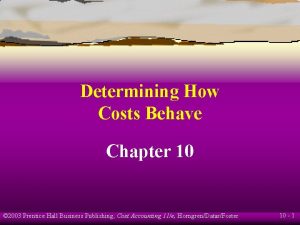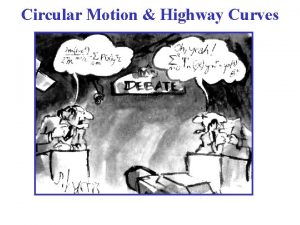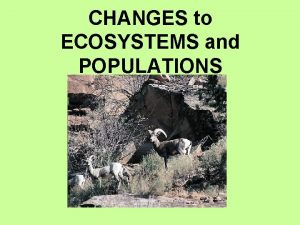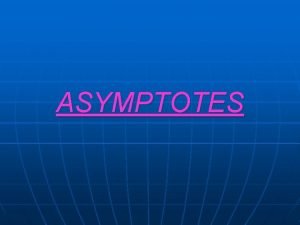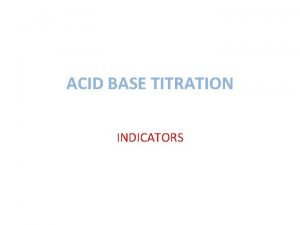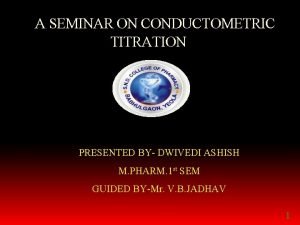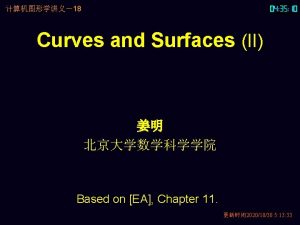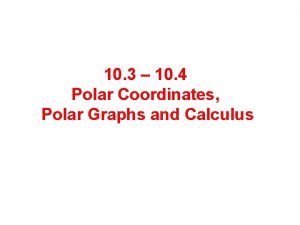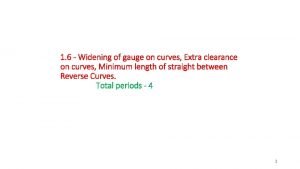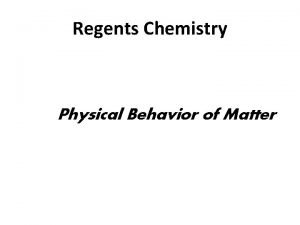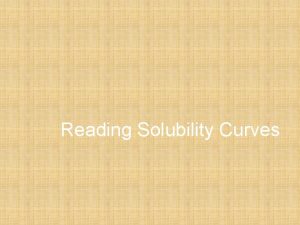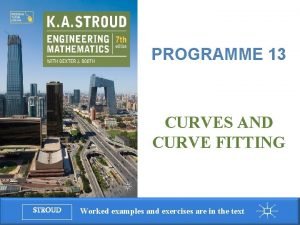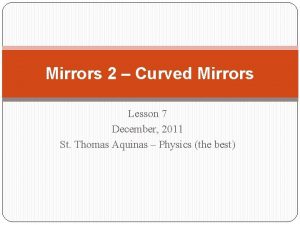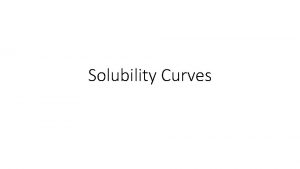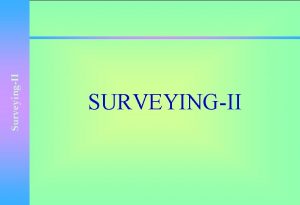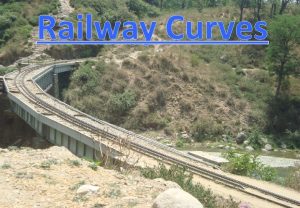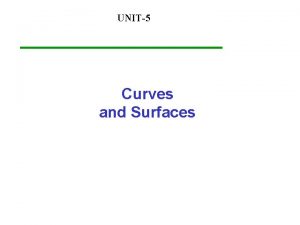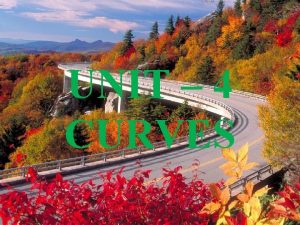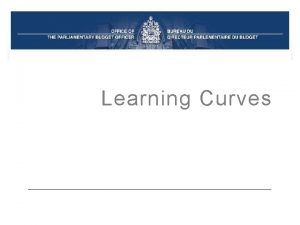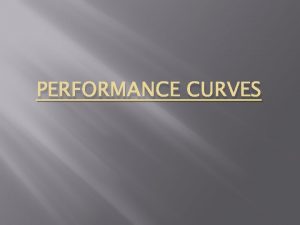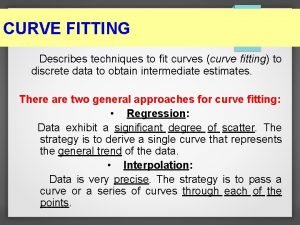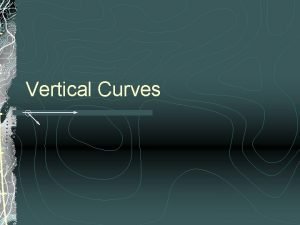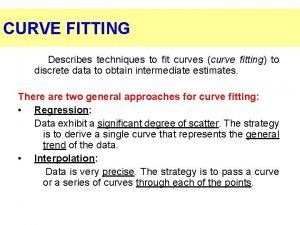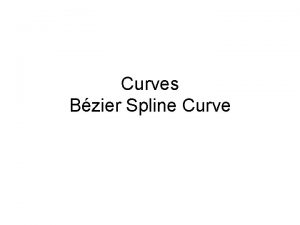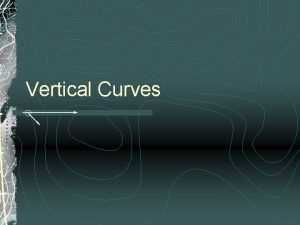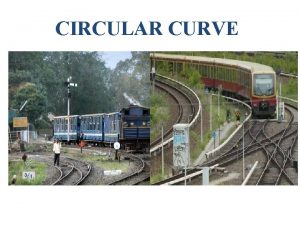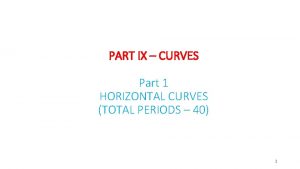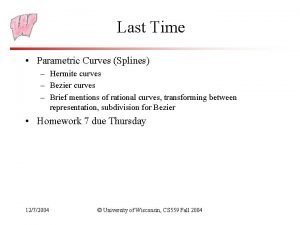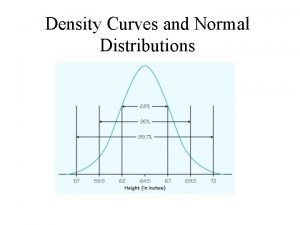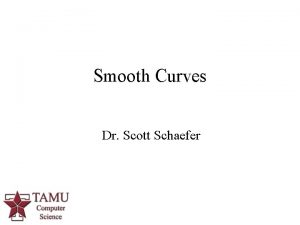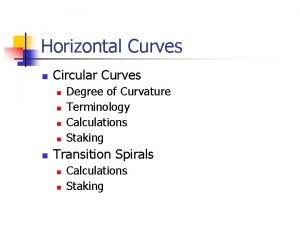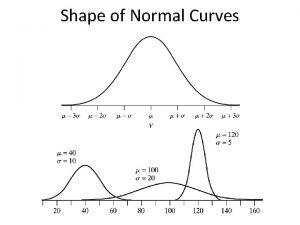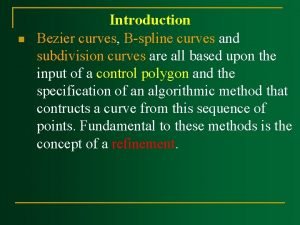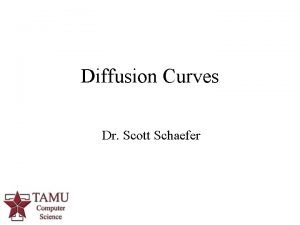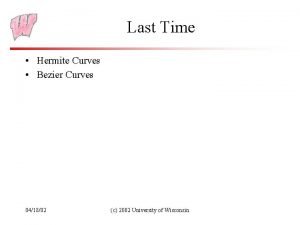Part III Curves Concept of curve 1 1
















































- Slides: 48

Part – III Curves; Concept of curve 1. 1 Types of Curves, Degree of Curve, Relation between degree & Radius, curve boards & rail post Total periods - 1 1

INTRODUCTION • It is desirable to follow the straight alignment but to be changed by introduction of curve(s)for some unavoidable reasons • Connectivity to sources of traffic. • Obstructions like hills, water bodies etc. • Unstable geological formations etc. • Technical and economical considerations when river alignment, length of bridge, need for climbing steep hills. 2

• Due to the forces on a curved track, it has been estimated that the maintenance effort on curves is about 25% extra over that on a straight track. • Therefore the forces and their effect on track, vehicle and passengers are required to be systematically studied so that curves are properly designed and easily maintained. • Better understanding the vehicle movement on curves and proper laying, maintenance, realignment of curves etc track engineers will be in better position to maintain 3

Types of curves Different types of curves in the track are: • Simple curves • Compound curves • Reverse Curves 4

IDENTIFICATION OF CURVE • Curve is a line of which no part is straight and which changes direction without angles. • A railway curve is a track which changes alignment without any sharp corners in rails. • This change of alignment through curves is best attained through circular curve. • A circular curve has the advantage of uniform curvature means uniform change of direction. • Identification: R- radius, D- degree, direction of curve : LH/RH 5

6

7

8

9

APEX DISTANCE OPTION I (Min. Radius computed) OPTIMUM OPTION II CHOOSING APPROPRIATE CURVE 10

How does the train move on rails? • Vehicle shall be Self centering/ self stabilising • Coning is the main mechanism • SINUSOIDAL MOTION. 11

Movement of wheels on a straight track • Coning of wheels helps to keep the vehicle centrally aligned on a straight and level track also. • Slight irregularities in the track do occur as a result of moving loads and the wheels, therefore, move from side to side and the vehicles sway. Due to the coning of wheels, this side movement results in the tread circumference of one wheel increasing over the other.

Movement of wheels on a straight track • As both the wheels have to traverse the same distance, this causes one wheel to slide. Due to the resistance caused by the sliding, any further side movement is prevented. • If there was no coning, the side movement would have continued and the flange of the wheel would have come in contact with the side of the rail, causing jerks and making the ride uncomfortable. 13

Behavior of coned wheel in curved track • On Outer rails wheel has to cover great distance than inner rail • Vehicle has tendency to move sideways towards outer rail • Circumference of flange of outer wheel will be greater than that of inner wheel • Helps the outer wheel to cover longer distance than inner rail 14

15

ADVANTAGES OF CONING THE WHEELS • Helps in reducing wear & tear of the wheel flanges and rails, which is due to rubbing action of flanges with gauge face of the rail head • Provides possibility of lateral movement of the axle with its wheels • Prevent the wheels from slipping to some extent 16

Wheel set on track: play helps wheel movement σs/2 σs= Standard Play σs/2 17

Sinusoidal motion of wheel set on straight 18

Guidance of wheel on track • Straight track • Sinusoidal motion • Curved track • Shifting of center of gravity of wheel set • Actual guidance of the wheel flange by the outer rail in sharper curves • Slipping/skidding of wheels on sharp curves 19

Angularity of axle while negotiating a curve α Angle of attack 20

Curve designation • Curves are Designated By Their Radii, Except On IR & US rail roads where degree of curve is used for designation and • • • Radii For Calculation. Limiting radii (item-2 chapter I of SOD ) BG : 175 M MG : 109 M NG : 44 M 21

DEGREE OF CURVE IS THE ANGLE SUBTENDED BY 30. 5 m CHORD AT THE CENTRE 30. 5 m (100 feet ) R D R 22

RELATION BETWEEN DEGREE AND RADIUS OF THE CURVE • The value of degree can be found out, as indicated below • Angle subtended by 2 Rm Length i. e; circumference=360°. • Angle (D) subtended by 1 m Length i. e; circumference i. e D = 360° X 1 / 2 R. • Angle (D )subtended by an arc of 30. 5 m length D = 360° X 30. 5 / 2 R = 1746. 81 / R Say D = 1750 / R

Degree of Curve - Exercise Find Radius. If Degree of Curve is • 0. 50° • 2° • 4° • 5° - 3500 m 875 m 437. 5 m 350 m

CURVE MEASUREMENT: BY VERSINE (MID CHORD OFFSET ON 20 m CHORD) By Property Of Circle, V*(2 R-V) = C/2*C/2 i. e. 2 RV=C 2/4 [NEGLECTING V 2] 2 i. e. Versine, V = C /8 R V C 2 R 2 R-V R C V 25

Versine - Exercise Find Versine on 20 m Chord – If Degree of Curve is • • 0. 50° 1° 4° 5° - 14. 28 mm 28. 57 mm 114. 28 mm 142. 80 mm

PARAMETERS OF CURVES • RADIUS, R AND DEGREE OF CURVE, D • ACTUAL CANT Ca • CANT DEFICIENCY Cd • CANT EXCESS Cex • EQUILIBRIUM CANT Ce / EQUILIBRIUM SPEED Ve • RATE OF CHANGE OF ACTUAL CANT rca • RATE OF CHANGE OF CANT DEFICIENCY rcd • CANT GRADIENT, i • LENGTH OF TRANSITION, L 27

Centrifugal & Centripetal Force 28

Effects of curve: Centrifugal force • Vehicle Running at a Speed of V In a Curve of Radius R experiences Centrifugal Force = MV 2/R • UNDESIRABLE EFFECTS • Possible passenger discomfort • Possible displacement of loads • Risk of vehicle overturning 29

Effects of curve: Centrifugal force • Risk of derailment • High lateral force resulting in maintenance problems • Wear of rail & wheel flange • Lateral force on track structure 30

PART IX – CURVES Part 2 VERTICAL CURVES (TOTAL PERIODS – 05) 31

2. 1 Need for vertical curve

Vertical curves 33

Vertical Curves: Why consider Safety: a)Summit type vertical curves: The centrifugal force acts upwards. This is opposite to the weight of the vehicle and causes off-loading (reduction in wheel load) of the vehicles. The offloading of wheels if coupled with lateral forces may lead to derailment of vehicle on track. b)Sag type vertical curves: The centrifugal force acts downwards. However, if the train is on sag type vertical curve and brake is applied from locomotive, the front portion near locomotive will start decelerating, whereas the rear portion, which is on a down gradient, will continue to move forward due to the effect of gravity. In such a case, the vehicles may bunch together and if the vehicles on the sag are empty, these may get lifted up, causing off-loading. In this case, the vehicles may be prone to derailment.

Vertical Curves: Why consider

Vertical Curves 36

Need of a Vertical Curve • Vertical curves are required to be provided only where the difference in the gradients meeting is large and the forces generated may lead to unsafe conditions / discomfort. • The vertical curves provided on IR are circular. • In vertical curves, there is no requirement of transitions, since there is no super elevation and also since the forces generated are small due to the very large radii of the vertical curves. 37

VERTICAL CURVES • Vertical Curves Are Provided At Those Locations Where Algebraic Difference Between The Grades Is Equal To Or More Than 0. 4% (4 mm/m) ROUTE A B C, D, E &MG MIN. RADIUS (m) 4000 3000 2500 38

Vertical Curves • Summit type vertical curves • Sag type vertical curves 39

Vertical Curves • Important issues • Vertical acceleration • Drainage • Visibility • Shall be as flat as possible • Not allowed in • points and crossing • unballasted deck girder bridges • transition portion of horizontal curves • Summit type curves can be provided only in formation 40

PROBLEM 41

SOLUTION 42

SOLUTION 43

SOLUTION 44

SOLUTION 45

Working example • Instructor to give one example and ask the trainees to solve in class • 2 periods.

CURVE BOARD & INDICATION Indicators/Boards Provided in Curves: (1) Curve Board–Each approach of a curve should be provided with a curve board at the tangent point fixed on the outside of the curve. This Board should indicate the radius of the curve, the length of the curve, length of transition in metres and the maximum cant provided on the circular portion of curve in millimetres. (2) Rail Posts Indicating Tangent Points– On the inside of the curve, rail posts should be erected on each approach of the curve, to indicate the positions of the beginning and end of transition curves. These rail posts may be painted in red and white colours respectively. In the case of non-transitioned curve, similar rail post should be erected on the tangent track and on the circular curve over which the cant is run out, indicating the beginning and end of the virtual transition.

Thanks
 Hamlet act iii scene iii
Hamlet act iii scene iii Va handbook 5017 part iii appendix a
Va handbook 5017 part iii appendix a Hill equation for hemoglobin
Hill equation for hemoglobin S curve and j curve
S curve and j curve Importance of balanced occlusion
Importance of balanced occlusion Biotic potential and environmental resistance
Biotic potential and environmental resistance This leads the balance wheel through the belt connection
This leads the balance wheel through the belt connection Part whole model subtraction
Part whole model subtraction Unit ratio definition
Unit ratio definition Brainpop ratios
Brainpop ratios Define technical description
Define technical description Front bar equipment
Front bar equipment The part of a shadow surrounding the darkest part
The part of a shadow surrounding the darkest part Minitab adalah
Minitab adalah Ideal self is
Ideal self is Contoh marketing concept
Contoh marketing concept Space curves
Space curves Symmetrical frequency curve
Symmetrical frequency curve Titration curve for arginine
Titration curve for arginine Isometric drawing with curves
Isometric drawing with curves Some animals are dangerous *
Some animals are dangerous * How is a supersaturated solution made
How is a supersaturated solution made Area between two curves formula
Area between two curves formula Redox titration definition
Redox titration definition Railway curves iricen
Railway curves iricen Creating production possibilities schedules and curves
Creating production possibilities schedules and curves S and j curves
S and j curves Mirror curved outward
Mirror curved outward Glycine titration curve
Glycine titration curve Intersection of solids examples
Intersection of solids examples Cooling curve
Cooling curve Beam strength of gear tooth definition
Beam strength of gear tooth definition Rectangular hyperbola engineering drawing
Rectangular hyperbola engineering drawing Is a cycloid a conic section
Is a cycloid a conic section Area of polar curves practice
Area of polar curves practice Learning curves 2003
Learning curves 2003 Highway curves banked and unbanked
Highway curves banked and unbanked S and j curves
S and j curves Asymptote of a curve
Asymptote of a curve Strong acid titration curve
Strong acid titration curve Advantage of conductometric titration
Advantage of conductometric titration 18curves
18curves Polar curve
Polar curve Widening of gauge on curves
Widening of gauge on curves Drivers ed module 5 topic 1
Drivers ed module 5 topic 1 Physical behavior of matter heating and cooling curves
Physical behavior of matter heating and cooling curves How to read a solubility curve
How to read a solubility curve 13 curves
13 curves Uses of convex mirror
Uses of convex mirror


